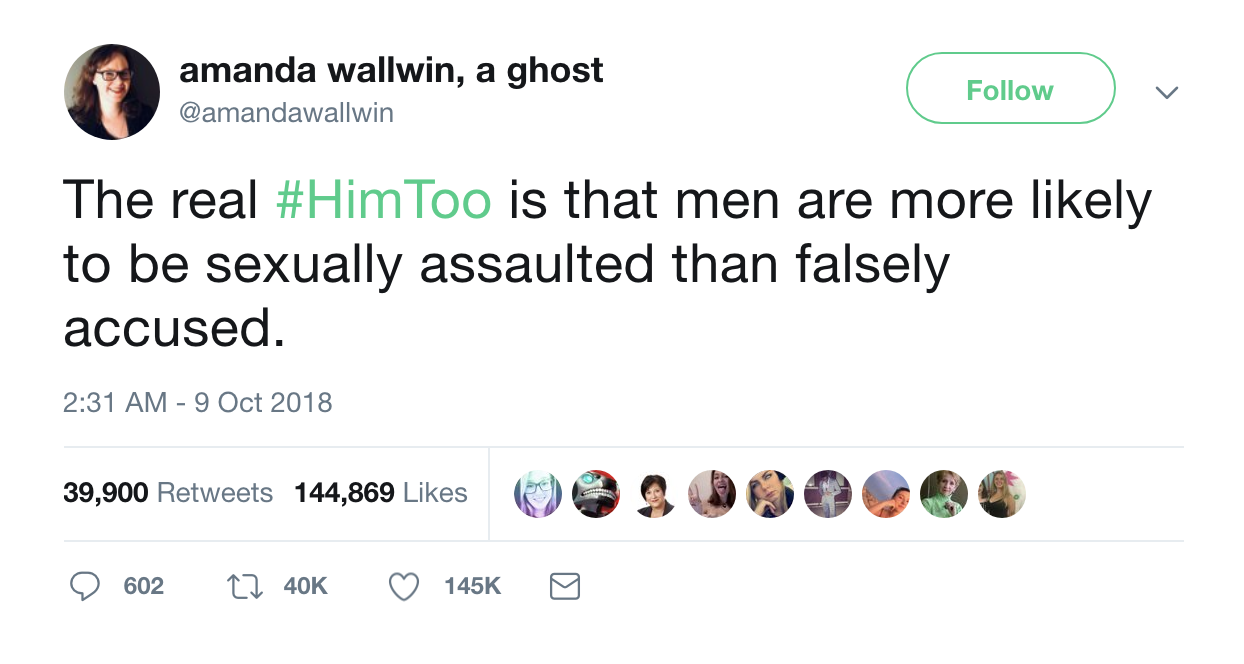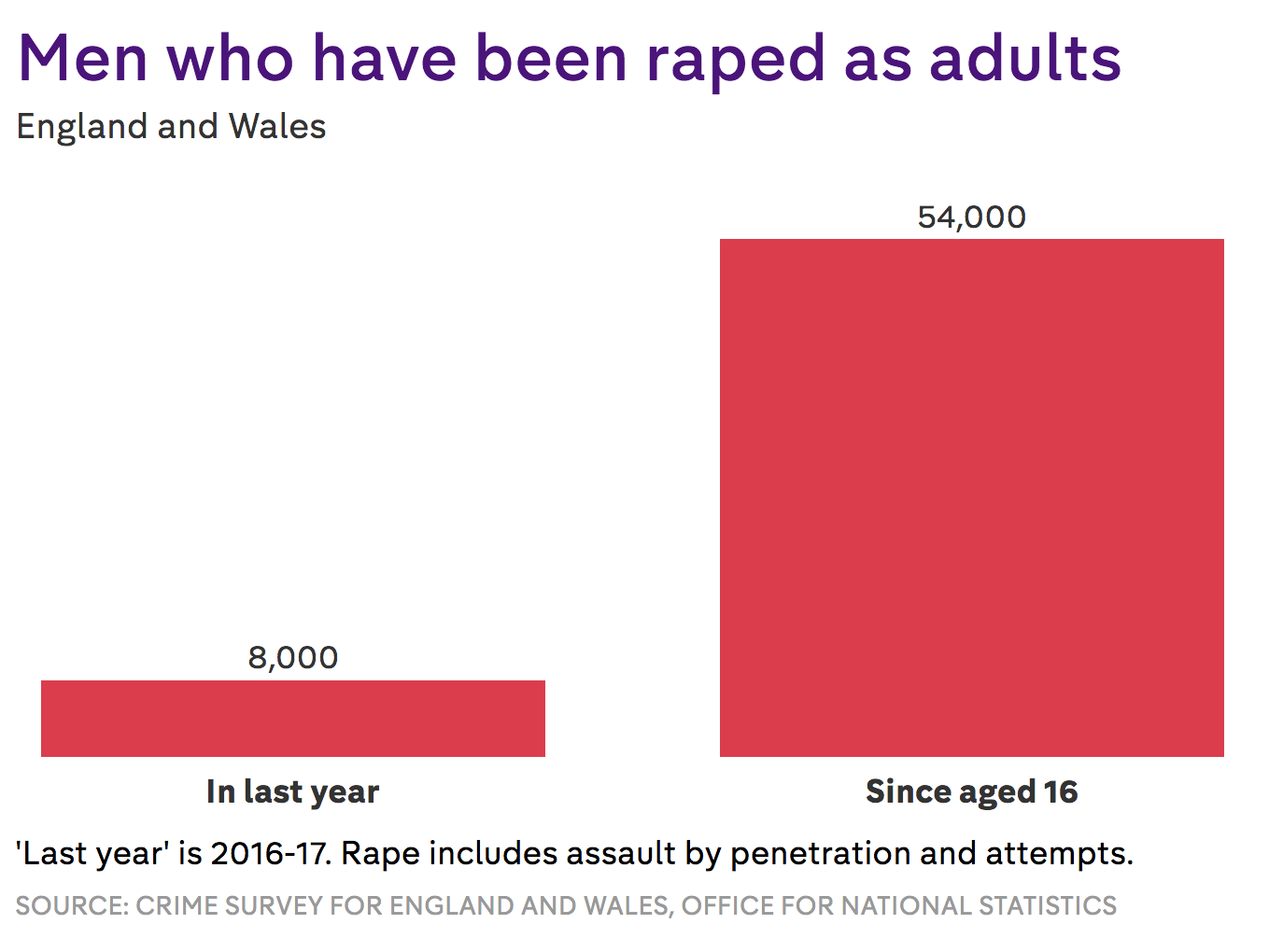You might have seen this tweet go viral this week. It’s obviously struck a chord, with over 140,000 likes at the time of writing.
So is it true?
Which crimes are we looking at?
For the purposes of this article, we’re going to look at rape, attempted rape, and assault by penetration where the victim is an adult. We won’t look at other types of sexual offence as we don’t have comparable data for false allegations relating to these crimes.
In law, a person has committed rape if “he intentionally penetrates the vagina, anus or mouth of another person with his penis” without the consent of the other person and without a reasonable belief that that other person has consented. You need to have a penis in order to rape an adult.
A person has committed assault by penetration if they intentionally penetrate the vagina or anus of another person with a part of their body “or anything else” in a way that is sexual, non-consensual, and without a reasonable belief that the person being penetrated has consented. You do not need to have a penis in order to commit assault by penetration.
In line with the Office for National Statistics, we’re going to group these three offences together in this article. We will use the term “rape” to cover all of these.
How many men are victims?
The Crime Survey for England and Wales (CSEW) estimates that 8,000 men were raped at some point in the 12 months up to March 2017. That’s about 0.05 per cent of adult men aged 16-59.
The CSEW also found that an estimated 54,000 men had been raped at some point in their adult lives, i.e., since the age of 16. That’s about 0.3 per cent of men. To be clear, these figures do not include men who were raped as children.
For comparison, 1.1 million women have been raped at some point since they were 16, which is just over 6 per cent of women. Of those, an estimated 144,000 women were raped in the 12 months to March 2017, which accounts for 0.9 per cent of women.
Why are we using the Crime Survey and not police records to measure victims?
The CSEW is run annually by the Office for National Statistics. They interview a random sample of 50,000 people across England and Wales and ask whether they have been a victim of crime in the previous 12 months.
When it comes to measuring sexual offences, statisticians prefer the CSEW because its own results show that around 80 per cent of sexual assault victims don’t report their experiences to the police. (Although police forces are making improvements to how they record this type of crime).
How many men are accused of rape?
So we have a sense of how many men are the victims of rape, but what about those men that are accused of carrying out a rape?
First up, let’s acknowledge the elephant in the room: there is no reliable data that exists to tell us how many people are accused of rape in day-to-day life.
There are all sorts of environments — at work, at home, in public — where someone could make an allegation of rape, truthfully or otherwise, that may go unrecorded. If false, these accusations could have far-reaching and profound effects on the accused’s life, even if they never result in police or judicial action.
But we can only analyse the data we have. So, for the purposes of this article, we will look at rape allegations that make it to the courts.
To aid comparison with the number of victims, we’ll stick to figures for the financial year 2016-17.
Let’s look at data from the Crown Prosecution Service, which here groups some more offences into the category of “rape” than the ONS — adding rape of a minor and conspiracy to commit these offences. The CPS figures show that a total of 5,118 men were prosecuted for rape (or these related offences) in the 12 months up to March 2017 in England and Wales. In the same year, 64 women were also prosecuted.
How many men are falsely accused of rape?
Over 5,000 people were prosecuted for rape in 2016-17. But only 2,991 were convicted. Does that mean the remaining 2,199 defendants were all victims of a false allegation?
In short: no.
Not being convicted of a crime is not the same as being found innocent. A criminal trial is about the prosecution trying to prove beyond reasonable doubt that the defendant is guilty. The defence does not have to prove that the defendant is innocent. We can’t say that every failed conviction means the alleged victim was lying.
And there are plenty of other reasons why prosecutions are not successful. For example, the victim may retract the allegation, the victim might not show up to court on the day of the trial, or there might be an essential legal element missing in the prosecution’s case.
But hang on, surely if the victim retracts the allegation, that’s proof that they were making it up, right? Well… not quite.
Of the 2,199 unsuccessful rape prosecutions in 2016-17, some 209 cases did not continue because the victim retracted their claim.
It’s entirely possible that some of these alleged victims made a false allegation and decided to pull out of the trial process. A 2013 CPS report into false rape allegations found that “it was a feature of these cases that the [person believed to have made a false allegation] later reported that the whole thing had spiralled out of control and he or she had felt unable to stop the investigation.”
However, evidence from the same CPS study shows that genuine victims of rape are sometimes coerced or intimidated into retracting their claims.
The 2013 report found that “there is a presumption that people do not admit things contrary to their own interests. However, this is often shown not to be true in domestic violence cases, where victims may be put under pressure to admit to having made a false allegation.”
The closest we can get to an official figure for the number of false rape allegations is how many people were prosecuted for perverting the course of justice or wasting police time after making a rape claim.
The latest data on this is from a 17-month period in 2011 and 2012, when the CPS prosecuted 35 people for making false allegations of rape.
Undoubtedly, there will be other cases of false allegations being made where there was not enough evidence to bring a prosecution of wasting police time or perverting the course of justice. But we don’t have data to quantify this.
Overall, in the CPS’ view, false allegations of rape are “serious but rare”. They estimate that there is one prosecution for a false rape claim out of every 161 rape cases prosecuted. That means — according to the best available data — false allegations make up 0.62 per cent of all rape cases.
Are men more likely to be the victim of a rape than falsely accused of committing rape?
The data we have is not always directly comparable and may not give us a complete picture of this complex issue.
But from what we can tell: yes, men are more likely to be raped than be falsely accused of rape.
According to the most reliable data we have, the average adult man in England and Wales aged 16 to 59 has a 0.03 per cent chance of being raped over the course of a year (based on 2016-17 figures).
The best data we have — the number of people prosecuted for making false allegations — suggests that the average adult man in England and Wales has a 0.00021281 per cent chance of being falsely accused of rape in a year. (That’s based on 35 prosecutions for false rape allegations in 2011 compared to 16.5 million men aged 16 to 59 living in England and Wales at the time).
By this measure, a man is 230 times more likely to be raped than to be falsely accused of rape.
And let’s put the stats through an even stronger test.
Imagine for a second that you believe that every single one of the men prosecuted for rape in England and Wales in 2016-17 was falsely accused.
Even if that unlikely scenario were true, there would still have been more adult male victims of rape (8,000) than men prosecuted for those rapes they “didn’t commit” (5,190).






